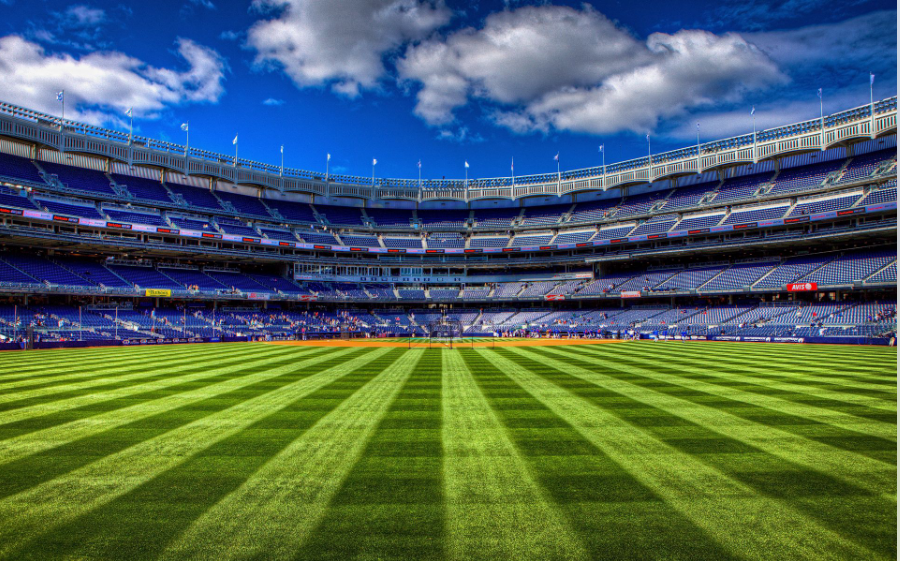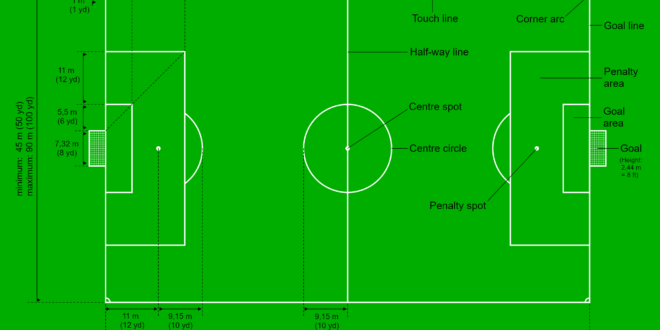A professional soccer field also known as a football pitch, typically measures between 100 to 130 yards (90-120 meters) in length, and 50 to 100 yards (45-90 meters) in width. These dimensions can vary based on the rules of specific organizations.
Soccer is a global sport with a vast fan base, and the size of its playing field is a crucial aspect that affects the game’s dynamics. Professional soccer fields must adhere to regulations set by governing bodies such as FIFA, which ensures a standardized playing experience worldwide.
The size of the pitch not only influences the style and speed of play but also impacts players’ strategies and conditioning. A professional soccer field larger field can benefit teams with greater stamina and speed, while a smaller pitch can lead to a faster, more controlled game. Playing on a field that meets professional standards allows athletes to perform at their highest level, showcasing their skills in a space designed for peak competition.

Introduction To Professional Soccer Fields
Table of Contents
Welcome to the world of professional soccer, where the field itself plays a crucial role in the beautiful game. Each blade of grass on a pro soccer field is a stage set for the theater of sport, where dimensions matter just as much as the skills of the players.
The Basics of A Soccer Pitch
The standard soccer field is a large rectangle, marked with lines that players must navigate. The field’s length varies from 100 to 110 meters (110-120 yards), and its width ranges from 64 to 75 meters (70-80 yards).
- Touchlines: The longest sides of the rectangle.
- Goal lines: The shorter sides where the goals are placed.
- Penalty Area: A box in front of each goal for penalty kicks.
- Center Circle: A circle in the middle where games start.
Let’s look at the layout:
| Field Area | Dimension |
|---|---|
| Length | 100 – 110 meters |
| Width | 64 – 75 meters |
| Penalty Area | 16.5 meters from Goal Line |
| Center Circle Radius | 9.15 meters |
Importance of Regulation Size
Professional soccer demands consistency, thus a regulation-size field is a must. This level playing field ensures fair matches. Teams train on standard pitch sizes to perfect techniques and strategies. Field size also affects players’ stamina and game speed. A bigger field means more ground to cover, changing the game’s dynamics entirely.
Key points to note about regulation sizes:
- Uniform gameplay: All teams play under the same conditions.
- A regulation field prepares players for all levels of play.
- Influences tactics: Coaches plan based on assured field dimensions.

Historical Evolution of Field Dimensions
The Historical Evolution of Field Dimensions is a fascinating aspect of professional soccer. Over time, the size of the field, also known as the pitch, has seen several changes. These modifications directly impacted how the game unfolded and the strategies used by teams.
Early Soccer Playgrounds
During the early days of soccer, each match was played on a field of varying sizes. Different local rules influenced the dimensions, affecting gameplay significantly. Fields ranged from very small to exceptionally vast. Playing areas were often shaped by the available space in public squares or regional common grounds.
Standardization Efforts
In the late 19th century, standardization efforts emerged as soccer gained popularity. The first rules set forth by the Football Association in 1863 included field size guidelines. Dimensions stipulated a rectangular shape but allowed considerable range, with lengths between 100 and 200 yards and widths from 50 to 100 yards.
International competition made standardization critical. FIFA adopted fixed dimensions in 1904, further refining field size.
Today’s professional soccer fields follow strict guidelines:
- Length: 100 to 110 meters (110 to 120 yards)
- Width: 64 to 75 meters (70 to 80 yards)
A FIFA-approved field ensures fair play and consistency across global matches. Though dimensions are more rigid now, variations within the rules still permit customization to suit different play styles and stadium sizes.
Fifa Regulations on Field Size
Professional soccer demands precise field dimensions. Without consistent sizing, the beautiful game lacks fairness and standardization. The Federation Internationale de Football Association (FIFA) ensures uniform play by setting strict regulations for field size. Knowing these rules helps players, coaches, and fans understand international and club-level play. Let’s explore FIFA’s regulations, focusing on the minimum and maximum dimensions, and variances allowed for international matches.
Minimum And Maximum Dimensions
- Length: The touchline must be between 100 meters (110 yards) and 110 meters (120 yards).
- Width: The goal line spans from 64 meters (70 yards) to 75 meters (80 yards).
| Dimension | Minimum | Maximum |
|---|---|---|
| Length (Touchline) | 100m (110yds) | 110m (120yds) |
| Width (Goal Line) | 64m (70yds) | 75m (80yds) |
FIFA’s rules ensure all professional fields share similar characteristics. Whether a local club or a World Cup stadium, fields adhere to these dimensions. This uniformity keeps the game fair and consistent across the globe.
Variances For International Play
Soccer fields may vary, especially in international contexts. FIFA permits certain deviations to accommodate the needs of the global sport. For instance:
- Competitions: Certain tournaments may have field size preferences. FIFA assesses each case and allows slight changes.
- Existing Structures: Some stadiums, due to their pre-existing construction, cannot alter their field size. FIFA understands and sometimes approves small variances.
Countries with smaller stadiums or those facing geographical constraints work with FIFA to ensure fields are within accepted ranges. The aim is to maintain play quality without stringent conformity.
Through these regulations, FIFA continues to uphold the global integrity of soccer. In grassroots or grand stadiums, players step onto the field knowing they compete on a level playing field.
Comparing Field Sizes: Club Vs. International Matches
The size of a soccer field plays a crucial role in the game. You might wonder if there’s a difference between the fields used in club matches and those in international games. Let’s delve into the specifics of how these playing arenas vary from each other.
Club Football Pitch Dimensions
Club football pitches can vary in size. Clubs adhere to the rules set by their respective leagues. Despite this, guidelines exist to maintain consistency. Fields must fall within certain dimensions:
- Length: 100 to 110 meters (110 to 120 yards)
- Width: 64 to 75 meters (70 to 80 yards)
These dimensions ensure players enjoy a uniform playing experience across different venues.
Differences In International Arenas
FIFA, the international governing body of soccer, dictates the size of the fields for international matches. Fields must follow strict size regulations to ensure fairness in games:
- Length: 100 to 110 meters
- Width: 64 to 75 meters
This consistency is vital for international play where high stakes and uniform conditions are crucial.
| Type of Match | Minimum Length | Maximum Length | Minimum Width | Maximum Width |
|---|---|---|---|---|
| Club Matches | 100 meters | 110 meters | 64 meters | 75 meters |
| International Matches | 100 meters | 110 meters | 64 meters | 75 meters |
While the sizes may appear similar, clubs have more flexibility within the range. International fields, on the other hand, must meet precise standards for official matches to be sanctioned by FIFA.
The Geometry of The Soccer Pitch
The geometry of the soccer pitch is crucial for the flow of the game. Not just a patch of grass, but a meticulously designed area, a professional soccer field adheres to specific dimensions and markings. Each line and curve hold a particular significance, impacting how the game is played. Let’s explore the complexity behind the green canvas of soccer.
Markings And What They Represent
These lines and shapes guide players and officials through the game:
- Touchlines: Longest sides of the pitch, define out of bounds.
- Goal lines: Short sides with goals, also mark the pitch boundary.
- Center circle: Sphere for kick-offs, radius of 9.15 meters.
- Penalty spots: Point for penalty kicks, 11 meters from goals.
Each marking holds a rule or an alert; players must respect them or face penalties.
Penalty Areas And Their Significance
Near the goals, the penalty areas are vital:
- Hosts the goalkeeper’s territory, where they can handle the ball.
- A space where fouls can become penalty kicks is critical in match outcomes.
- Dimensions: 18 yards out from the goal line, extending 18 yards to each side.
The penalty area’s severity reminds players to be cautious and strategic.
Impact of Field Size On Playing Style
Did you know that a soccer field’s size can change how a game is played? Big fields give players more room. Small fields mean less space but faster action. This can mix up a team’s game plan!
Strategies For Large Vs. Small Pitches
Teams use different tactics for different field sizes. On big pitches, there’s more space for long passes and wide attacks. Players can spread out, making it hard for the other team to defend. On small pitches, the game speeds up. Teams often press high and pass quickly to beat tight spaces.
- Large pitches:
- Focus on stamina and speed
- Use the whole field for play
- Exploit space with long passes
- Small pitches:
- Quick, short passing is key
- Tight teamwork matters more
- Use smart moves to create space
How Players Adapt To Different Sizes
Soccer pros adjust their style for the field size. On a large pitch, a player might take more risks. They might try running far with the ball. But on a small pitch, they keep things simple. Quick passes and fast decisions are the tricks!
| Field Size | Player Adjustment |
|---|---|
| Large Pitch | Risk-taking, wide attacks |
| Small Pitch | Quick passes, tight play |
Technological Advances In Field Design
Professional soccer fields have undergone remarkable changes. Thanks to technology, today’s fields boast durability and precision unlike ever before. Innovations in turf technology and precision in measurement tools are at the forefront, ensuring optimal playing conditions for athletes.
Innovations In Turf Technology
Artificial turfs have evolved significantly. Technological strides have produced surfaces that mimic real grass in bounce and texture. These turfs offer consistent quality regardless of weather or heavy use. Here are some key advancements:
- Infills: Modern materials provide better shock absorption, reducing injury risks.
- Fiber Technology: Synthetic blades now have increased durability and a more natural feel.
- Drainage systems: Innovative designs ensure fields stay playable even after heavy rain.
Precision In Measurement Tools
Accurate field dimensions are crucial for fair play. Advanced measurement tools have made this task far easier and exact. Let’s explore essential tools that guarantee precision:
- Laser-guided systems: They deliver pinpoint accuracy for field layouts.
- GPS technology: Helps in mapping fields to exact specifications.
- Digital applications: Planners use apps to visualize and adjust field dimensions before construction.

Tending To The Turf: Maintenance of A Soccer Field
A professional soccer field is not just a stretch of grass; it’s a carefully cultivated stage for some of the world’s most thrilling sports action. Maintaining such a playing surface is an art that requires precision, dedication, and a deep understanding of horticulture and field management. Properly tended turf is essential for peak player performance and the overall beauty of the game.
Regular Upkeep Requirements
Regular upkeep is vital for a top-notch soccer field. Each strand of grass acts as a cushion for players and affects the ball’s roll. Here’s a snapshot of weekly tasks that keep the turf in prime condition:
- Mowing: A precise height ensures uniform playability.
- Watering: Balanced hydration prevents dry spots and promotes healthy growth.
- Aeration: This process reduces soil compaction.
- Fertilization: Key nutrients maintain the turf’s vibrant color and density.
Preparing For Seasonal Changes
As the seasons shift, so do the needs of a soccer field’s turf. Transitioning the field to accommodate weather changes is a skill that keeps the pitch in playable condition all year round. Below is an essential guide for seasonal care:
| Season | Care Tactics |
|---|---|
| Spring |
|
| Summer |
|
| Fall |
|
| Winter |
|
Major Tournaments And Their Field Specifications
Soccer fans and players alike revel in the excitement of major tournaments. A crucial aspect of these events is the professional soccer field size. Specific standards ensure fair play and optimal performance. Let’s dive into the specifications that make these tournaments unique.
World Cup Stadium Standards
The FIFA World Cup represents the pinnacle of soccer excellence. The field dimensions reflect the importance of this global competition:
-
- Length: Between 100m and 110m
- Width: Between 64m and 75m
- Grass quality: Top-grade for smooth gameplay
The pitch is meticulously maintained with precise markings. Uniformity across all venues is crucial.
Spectators’ space and safety are also part of the guidelines. World Cup stadiums adhere to stringent security and seating arrangements.
Uefa And Conmebol Requirements
European and South American tournaments follow UEFA and CONMEBOL regulations. These are similar to FIFA but have some distinct nuances:
| Organization | Length | Width |
|---|---|---|
| UEFA | 105m | 68m |
| CONMEBOL | 100-110m | 64-75m |
Standards for goal size and box dimensions also align closely with FIFA’s model. Stadium capacity and facilities must meet top-tier requirements.
Whether it’s the lightning speed of a counter-attack or a precision-set-piece, these field specifications set the stage for thrilling matches.
Conclusion: The Future of Soccer Field Design
Soccer fields are seeing changes. Innovations shape how they look and function. Fans and players expect modern and advanced fields. In this section, we explore what lies ahead.
Expectations For Upcoming Tournaments
Bigger events demand top-quality soccer fields. Fans look forward to the FIFA World Cup and similar tournaments with great anticipation. They want stunning arenas. Here’s what we expect:
- Regulation sizes will stay, allowing for fair play.
- Fields will offer advanced drainage systems to avoid delays.
- Surfaces might include hybrid turfs, blending natural and artificial grass.
- High-tech maintenance equipment will keep pitches in top condition.
Sustainability In Field Construction
The eco-friendly approach is hitting soccer fields too. Sustainable design is key. We are aiming for green solutions in every new soccer field. This includes:
- Using recycled materials for construction.
- Integrating water conservation systems to save resources.
- Employing renewable energy sources to power stadium facilities.
- Building with eco-conscious landscaping in mind.
Soccer fields will continue to evolve. The goal is clear: sustainable, impressive, and state-of-the-art arenas for the beautiful game’s future.
Frequently Asked Questions of Professional Soccer Field Size
What is the official size of a soccer field?
The official size for a professional soccer field varies. It measures between 100 to 130 yards (90-120 meters) in length and 50 to 100 yards (45-90 meters) in width. This size range is set by FIFA standards for international matches.
How wide is a pro soccer field?
A professional soccer field’s width ranges from 50 to 100 yards (45-90 meters). The optimal width is often around 75 yards (68. 5 meters) to accommodate professional play, adhering to regulations set by governing bodies like FIFA.
Are soccer field dimensions the same for all leagues?
Not all soccer fields are the same size. However, they must fall within the regulated size range set by FIFA. Professional leagues may have slight variations within this range, but dimensions typically stay consistent to maintain the standard of play.
Does field size affect soccer play quality?
Yes, the size of the soccer field can significantly affect gameplay. Larger fields may favor teams with better stamina and tactical spacing, while smaller fields can lead to a faster-paced game with more emphasis on skill and technique.
Conclusion
Understanding the dimensions of a professional soccer field is crucial for players, coaches, and fans alike. It ensures fair play and sets the stage for thrilling matches. Whether you’re constructing a new field or simply nurturing your love for the game, keeping these size standards in mind is key to aligning with the pros.
 SMGB TODAY Sports, Movies, TV Shows
SMGB TODAY Sports, Movies, TV Shows

